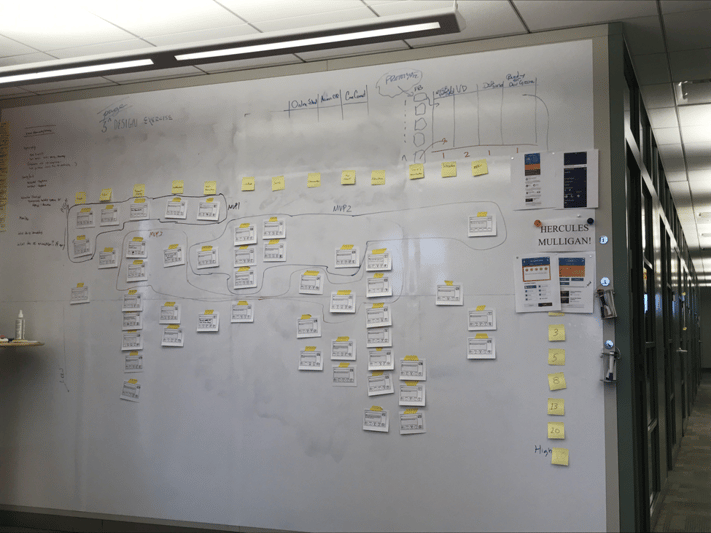User Story Mapping is an excellent technique to visualize how the solution is going to be iteratively developed in fast-feedback cycles. MVPs can be defined for various reasons such as validating the need for certain functionality, gaining user feedback on design decisions, or investigating technical techniques. The story map will visually show how the team will iterative develop working solutions and evolve toward a MMP (minimum marketable product).
The story mapping process starts out by listing the key capabilities and features that will make up the product along the top of the map and then showing a prioritized list of user stories underneath each capability. The magic happens when the team collaboratively starts to slice the story map horizontally into sprints or MVPs to agree on a plan to iteratively evolve the solution. Story mapping normally occurs during release planning and is revisited throughout the project. The conversation that happens between the product owner and the team to better understand the user stories, identify dependencies between stories, define MVPs with clear learning objectives and visualize how the solution is evolving toward a MMP is invaluable.

Many agile teams start with implementing robust agile software delivery processes primarily focused on the software teams. However, agile software delivery begins with agile product management. Agile product management is rooted in the principle of lean, just in time development and getting fast feedback.
Teams spend a lot of time and energy writing detailed user stories “As a <user> I would like to have <capability> so that <benefit>”. However, each of these user stories needs to represent an overarching capability. Typically, product owners and business analysts are tempted to jump straight into requirements gathering, story writing and bypass having the conversation to understand what needs to be built, why it needs to be built and what problems are solved for the end user.
User story mapping is an excellent technique to break down complex business projects into smaller, consumable and most importantly deliverable features that enable fast feedback from the end user. It aligns business and IT teams to gain a common understanding on what needs to be built and how.
The following are 7 benefits of user story mapping:
- Visual of the “Whole”: User story mapping gives a holistic visual and space to think about how things fall in place.
- Gap analysis: Teams are able to spot the missing pieces of the puzzle in the solution and can spend time on building solutions.
- Sequencing: Teams are able to move stories around on the user story wall to determine the sequence of process that an end user will experience and this enables the team to determine the MUST have stories that get the business intent delivered in an incremental manner.
- Priority: This is a critical outcome from the user story mapping session. The ability to sequence and determine what minimally needs to be built so that there can be a clear determination of priority enables the team to create detailed user stories just in time as well as build the user stories just in time.
- Avoid waste: Teams avoid gold-plating or building unnecessary features as a result of prioritization as they get a deeper appreciation of the whole solution that needs to be built.
- Big Picture: All participants better understand the big picture which leads to better conversation between product and IT teams.
- Shared understanding: Story mapping enhances shared understanding of each of the features and user stories for all participants. Everyone is able to connect the dots for how the smallest element (user story), maps to features, the releases and the overall product roadmap.
Start your journey to digital transformation with a solid vision of your digital strategy:
Interested in training to help advance your agile journey? Click the button to view our current list of public training courses! Use code BLOG10 for 10% off!

